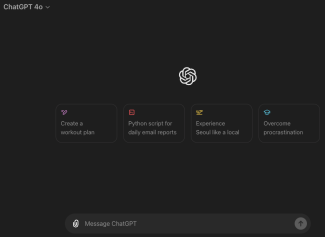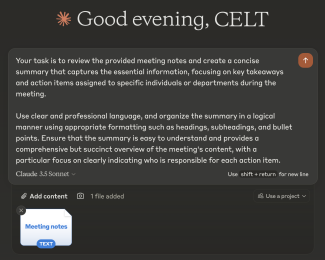Examples of GenAI
Generative AI Tools
While ChatGPT remains one of the most well-known generative AI tools, there are many others that have emerged as equal competitors. Below are brief descriptions of a few of the most common GenAI tools along with some notable differences between them. The variable features can impact the type of outputs that the tools generate based on a given prompt.
These technologies change frequently, often without warning, so instructors are encouraged to continually experiment with any tools they ask their students to use to remain up-to-date on functionality. Instructors are also encouraged to experiment with these tools and others to establish a better understanding of how they work.
ChatGPT
About ChatGPT
OpenAI's ChatGPT free version is currently ChatGPT 4o mini. The paid version is ChatGPT 4o which also includes access to building "GPTs" or trained agents that you can feed files to and coach to carry out particular processes and tasks. Those with the free version can access pre-created GPTs but cannot create GPTs themselves. The paid version of ChatGPT costs $20 a month.

ChatGPT Homepage
Copilot
About Copilot
Like ChatGPT, Microsoft's Copilot runs on a GPT-4 architecture. Students and instructors can log onto Copilot using their linkblue credentials. As with any AI at this point, UK users should still use caution about what information they include in their AI prompts.
Historically, Microsoft's generative AI (formerly Bing) has limited the number of questions users can ask. Microsoft claimed in this blog post that restrictions were made because "long chats can confuse the underlying chat model." Bing Chat itself stated that a recent 5-question limit was made due to "problems with the server." Question limits for Copilot are now limited to 30 per exchange, but you can open a new chat and start over.

Gemini
About Gemini
Gemini is Google's latest Large Language Model, replacing it's predecessor, Bard, in early 2024. Gemini runs on a different transformer than OpenAI's ChatGPT and Microsoft's Copilot. There are both free and paid versions of Gemini available for users. UK students and employees will need to sign into a personal Google account to access Gemini as it is not currently available for the g.uky.edu accounts available through UK.

Gemini Home Page
Claude
About Claude
Anthropic's Claude is one of the earliest free models to allow uploading of files. Claude still lacks is the ability to create images. Anthropic touts Claude as a generative AI model that is focused heavily on privacy and safety, which you can read more about here. Claude's latest update, Sonnet 3.5 offers a unique "artifact" window that shows the editable output beside the chat. Updates to their Opus and Haiku versions are due later this year.

Claude Home Page
Claude Screenshot